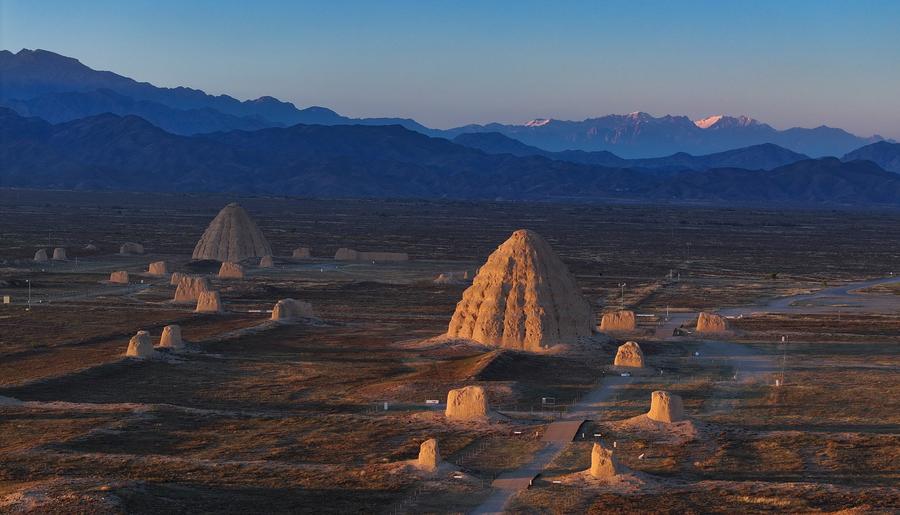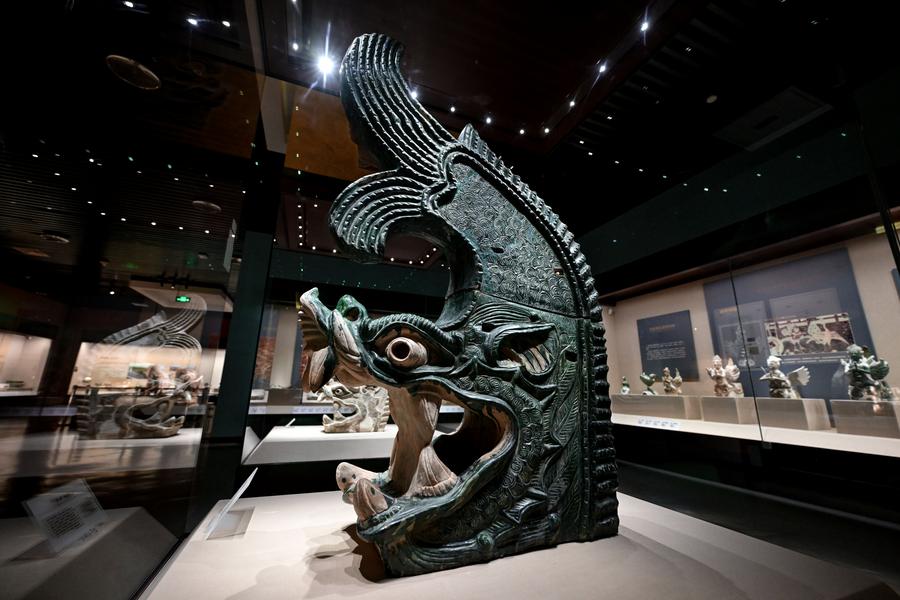
 0 Comment(s)
0 Comment(s) Print
Print E-mail Xinhua, December 16, 2024
E-mail Xinhua, December 16, 2024

An aerial drone photo taken on Oct. 22, 2024 shows two Xixia imperial tombs at the foot of Helan Mountain, northwest China's Ningxia Hui Autonomous Region. (Xinhua/Feng Kaihua)
Archaeological studies and excavations have this year produced significant insights into the flood control systems and cultural heritage of the Xixia Imperial Tombs in northwest China's Ningxia Hui Autonomous Region.
This burial complex, located at the foot of Helan Mountain, about 30 km west of Yinchuan, capital of Ningxia, was built by the Tangut (Dangxiang) people, an ethnic minority that prospered in agricultural-husbandry areas of northwest China between the 11th and 13th centuries.
Rich discoveries
To date, nine imperial tombs, 271 subordinate tombs, a 5-hectare complex of architectural ruins and 32 flood control sites, in addition to over 7,100 architectural components and finely crafted artifacts, have been uncovered at this site.
These findings have offered valuable insights into the sophisticated engineering, artistry and cultural achievements of the Xixia Dynasty (1038-1227).
Historical records indicate that during the Xixia Dynasty, various ethnic groups, including the Tangut, Han, Uygur and Tibetan peoples, coexisted. Their diverse livelihoods, religious practices and cultural customs enriched the Xixia heritage -- shaping its distinctive and multifaceted cultural identity.

A replica of glazed Chiwen, a roof ornament on ancient Chinese buildings, which was unearthed from a Xixia imperial tomb, is displayed at Ningxia Museum in Yinchuan, northwest China's Ningxia Hui Autonomous Region, Nov. 26, 2024. (Xinhua/Feng Kaihua)
"The mausoleums and their unearthed artifacts are tangible evidence of the dynasty's inheritance and development of Chinese traditional culture, encompassing architecture, script, political systems and agricultural techniques," said Du Jianlu, dean of the School of Ethnology and History at Ningxia University.
"As a multi-ethnic regime, Xixia culture was diverse and eclectic, yet it was predominantly shaped by the Chinese civilization. This cultural identification has been a powerful intrinsic force driving the formation and development of a sense of community for the Chinese nation," Du added.
The 32 flood control sites include 26 flood walls, spanning over 3,000 meters, and six flood drainage channels measuring more than 2,000 meters.
"These structures were used to manage rainwater and to mitigate flood impacts," said Chai Pingping, from Ningxia Institute of Cultural Relics and Archaeology, who is leading the archaeological program.
"Some of these flood control sites remain functional today and are worth further protection and study," Chai added.
Ongoing efforts at the site in Ningxia involve archaeological surveys and non-invasive archaeological exploration, with the latter techniques targeting solid mausoleum towers and underground palaces, which are unsuitable for excavation, aiming to determine material densities and study shapes and depths of tomb passages without excavation, said Ren Xiufen, from the cultural relics conservation office of the Xixia Imperial Tombs administration.
Protection & development
Since 2000, with support from government, reinforcement projects have been carried out on nine imperial tombs and 44 subordinate tombs within the Xixia mausoleum complex.
"We have continuously upgraded our methods in recent years. We've adopted advanced materials in combination with traditional techniques, in an effort to slow down environmental damage to the ruins," said Ren.
In 2015, the mausoleum introduced dynamic monitoring and early warning systems to enhance precision in its relics conservation efforts.
Meanwhile, technical experts have conducted annual site inspections to address emerging issues -- such as biological damage.
Efforts to popularize the Xixia legacy have included documentaries and collaborations with cultural tourism firms to develop interactive educational programs. Notably, visitors can participate in artifact restoration, woodblock printing and paper-cutting workshops, thereby making history both accessible and engaging.
Over 600 cultural and creative products, such as bookmarks, refrigerator magnets and Xixia-style porcelain items have offered visitors tangible connections to this historical heritage.
The site has hosted 508 study tours and summer camps in 2024, attracting 178,000 visitors.
This past summer, the Xixia mausoleums museum introduced a special exhibition highlighting the heritage value of the tombs. Utilizing 3D scanning, VR imaging and smart display cabinets, visitors are able to "interact" with artifacts and envision the ancient splendor of the mausoleum complex.
Wang Jiazhu, a visitor from eastern China's Jiangsu Province, was impressed by the mausoleums, the enigmatic Xixia characters and the advanced porcelain craftsmanship. "I never imagined that the Xixia, nestled in the northwest, had achieved such a remarkable level of civilization."
Go to Forum >>0 Comment(s)